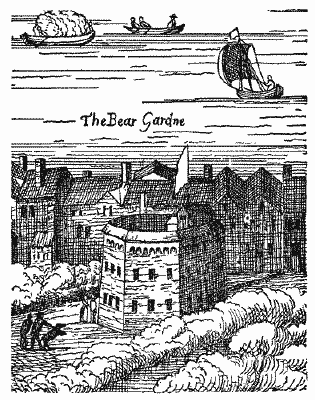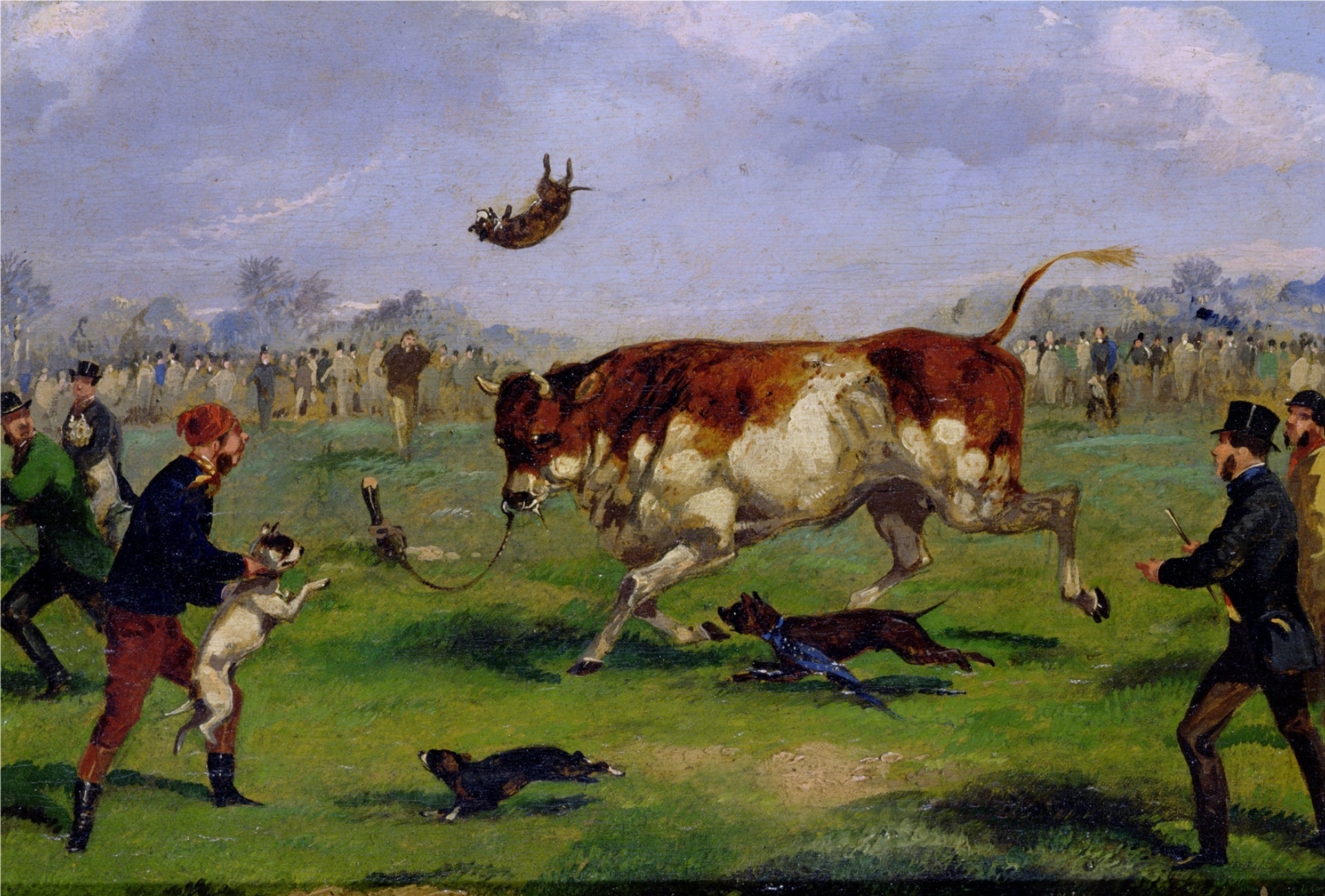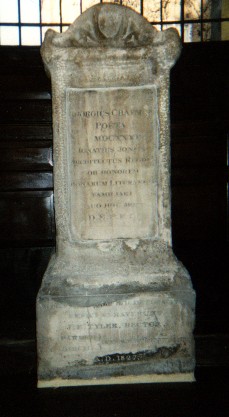|
Beargarden
The Beargarden was a facility for bear-baiting, bull-baiting, and other " animal sports" in the London area during the 16th and 17th centuries, from the Elizabethan era to the English Restoration period. Baiting is a blood sport where an animal is tormented or attacked by another animal, often dogs, for the purpose of entertainment or gambling. Samuel Pepys visited the venue in 1666 and described it as "a rude and nasty pleasure". The last recorded event at the Beargarden was the baiting of "a fine but vicious horse" in 1682. History The Beargarden was constructed as a round or polygonal open structure, comparable to the public theatres built in and around London starting in 1576. Contemporaneous illustrated maps of the city show a substantial three-storey building that resembles the theatres nearby. It was located in the Bankside, across from the City of London on the south bank of the River Thames in Southwark; but its exact location is unclear, and apparently changed over ti ... [...More Info...] [...Related Items...] OR: [Wikipedia] [Google] [Baidu] |
Edward Alleyn
Edward "Ned" Alleyn (; 1 September 156621 November 1626) was an English actor who was a major figure of the Elizabethan theatre and founder of the College of God's Gift in Dulwich. Early life Alleyn was born on 1 September 1566 in Bishopsgate, London; or so it was recorded in the ''Biographia Britannica'' as a product of Alleyn's own writing. Alleyn does record his birth date in a diary several times but not distinctly identifies his birthplace as Bishopsgate. In the St. Botolph parish registers it is recorded that he was baptized on the day after his birth. He was born a younger son of Edward Alleyn with three brothers named John, William, and Edward. His father was an innkeeper and porter to Queen Elizabeth I and his mother, Margaret Townley, was the daughter of John Townley. His mother's link to the Lancashire Townley family is somewhat of a mystery. Alleyn said she was the daughter of John Townley of Townley but the claim does not easily fit with the available informa ... [...More Info...] [...Related Items...] OR: [Wikipedia] [Google] [Baidu] |
Bear-baiting
Bear-baiting is a blood sport in which a chained bear and one or more dogs are forced to fight one another. It may also involve pitting a bear against another animal. History Europe Great Britain Bear-baiting was very popular from the 12th until the 19th century. From the sixteenth century, many bears were maintained for baiting. In its best-known form, arenas for this purpose were called bear-gardens, consisting of a circular high fenced area, the " pit", and raised seating for spectators. A post would be set in the ground towards the edge of the pit and the bear chained to it, either by the leg or neck. Several well-trained fighting or baiting dogs, usually Old English Bulldogs, would then be set on it, being replaced as they got tired or were wounded or killed. In some cases the bear was let loose, allowing it to chase after animals or people. For a long time, the main bear-garden in London was the Paris Garden, a section of the Bankside lying to the west of The Clink, a ... [...More Info...] [...Related Items...] OR: [Wikipedia] [Google] [Baidu] |
Bull-baiting
Bull-baiting is a blood sport involving pitting a bull against dogs. History England Crowds in London during the Royal Entry of James VI and I in March 1604 were entertained by bull-baiting. During the time of Queen Anne, bull-baiting was practised in London at Hockley-in-the-Hole, twice a week – and was also reasonably common in provincial towns, for instance at Birmingham's Bull Ring. At Tutbury, a bull was tied to an iron stake so that it could move within a radius of about 30 feet. The object of the sport was for the dogs to immobilize the bull. Before the event started, the bull's nose was blown full of pepper to enrage it before the baiting. The bull was often placed in a hole in the ground. A variant of bull-baiting was "pinning the bull", where specially-trained dogs would set upon the bull one at a time, a successful attack resulting in the dog fastening his teeth strongly in the bull's snout. The extinct Old English Bulldog was specially bred for this spo ... [...More Info...] [...Related Items...] OR: [Wikipedia] [Google] [Baidu] |
Philip Henslowe
Philip Henslowe (c. 1550 – 6 January 1616) was an Elizabethan theatrical entrepreneur and impresario. Henslowe's modern reputation rests on the survival of his diary, a primary source for information about the theatrical world of Renaissance London. Life Henslowe was born in Lindfield, Sussex, into a family with roots in Devon. His father, Edmund Henslowe, was appointed Master of the Game for Ashdown Forest, Sussex, from 1539 until his death in 1562. Before Edmund Henslowe's death, his daughter Margaret had married Ralf Hogge, an ironmaster. By the 1570s, Henslowe had moved to London, becoming a member of the Dyers' Company. Henslowe is recorded working as assistant to Henry Woodward, reputed to be the bailiff for Anthony Browne, 1st Viscount Montagu, owner of Cowdray House and Battle Abbey in Sussex. Henslowe married Woodward's widow, Agnes, and from 1577 lived in Southwark, opposite the Clink prison. His elder brother Edmund, a merchant, also owned property in S ... [...More Info...] [...Related Items...] OR: [Wikipedia] [Google] [Baidu] |
The Rose (theatre)
The Rose was an Elizabethan theatre. It was the fourth of the public theatres to be built, after The Theatre (1576), the Curtain (1577), and the theatre at Newington Butts (c. 1580?) – and the first of several playhouses to be situated in Bankside, Southwark, in a liberty outside the jurisdiction of the City of London's civic authorities. Its remains were excavated by archaeologists in 1989 and are listed by Historic England as a Scheduled Monument. History The Rose was built in 1587 by Philip Henslowe and by a grocer named John Cholmley. It was the first purpose-built playhouse to ever stage a production of any of Shakespeare's plays. The theatre was built on a messuage called the "Little Rose," which Henslowe had leased from the parish of St. Saviour, Southwark in 1585. The Rose was the first of several theatres to be situated in Bankside, Southwark near the south shore of the River Thames. The area was known for its leisure attractions such as bear/bull-baitings, gami ... [...More Info...] [...Related Items...] OR: [Wikipedia] [Google] [Baidu] |
Elizabeth I Of England
Elizabeth I (7 September 153324 March 1603) was Queen of England and Ireland from 17 November 1558 until her death in 1603. Elizabeth was the last of the five House of Tudor monarchs and is sometimes referred to as the "Virgin Queen". Elizabeth was the daughter of Henry VIII and Anne Boleyn, his second wife, who was executed when Elizabeth was two years old. Anne's marriage to Henry was annulled, and Elizabeth was for a time declared illegitimate. Her half-brother Edward VI ruled until his death in 1553, bequeathing the crown to Lady Jane Grey and ignoring the claims of his two half-sisters, the Catholic Mary and the younger Elizabeth, in spite of statute law to the contrary. Edward's will was set aside and Mary became queen, deposing Lady Jane Grey. During Mary's reign, Elizabeth was imprisoned for nearly a year on suspicion of supporting Protestant rebels. Upon her half-sister's death in 1558, Elizabeth succeeded to the throne and set out to rule by good counsel. S ... [...More Info...] [...Related Items...] OR: [Wikipedia] [Google] [Baidu] |
Richard III Of England
Richard III (2 October 145222 August 1485) was King of England and Lord of Ireland from 26 June 1483 until his death in 1485. He was the last king of the House of York and the last of the Plantagenet dynasty. His defeat and death at the Battle of Bosworth Field, the last decisive battle of the Wars of the Roses, marked the end of the Middle Ages in England. Richard was created Duke of Gloucester in 1461 after the accession of his brother King Edward IV. In 1472, he married Anne Neville, daughter of Richard Neville, 16th Earl of Warwick. He governed northern England during Edward's reign, and played a role in the invasion of Scotland in 1482. When Edward IV died in April 1483, Richard was named Lord Protector of the realm for Edward's eldest son and successor, the 12-year-old Edward V. Arrangements were made for Edward V's coronation on 22 June 1483. Before the king could be crowned, the marriage of his parents was declared bigamous and therefore invalid. Now officiall ... [...More Info...] [...Related Items...] OR: [Wikipedia] [Google] [Baidu] |
Puritan
The Puritans were English Protestants in the 16th and 17th centuries who sought to purify the Church of England of Roman Catholic practices, maintaining that the Church of England had not been fully reformed and should become more Protestant. Puritanism played a significant role in English history, especially during the Protectorate. Puritans were dissatisfied with the limited extent of the English Reformation and with the Church of England's toleration of certain practices associated with the Roman Catholic Church. They formed and identified with various religious groups advocating greater purity of worship and doctrine, as well as personal and corporate piety. Puritans adopted a Reformed theology, and in that sense they were Calvinists (as were many of their earlier opponents). In church polity, some advocated separation from all other established Christian denominations in favour of autonomous gathered churches. These Separatist and Independent strands of Puritanism bec ... [...More Info...] [...Related Items...] OR: [Wikipedia] [Google] [Baidu] |
Walter Raleigh
Sir Walter Raleigh (; – 29 October 1618) was an English statesman, soldier, writer and explorer. One of the most notable figures of the Elizabethan era, he played a leading part in English colonisation of North America, suppressed rebellion in Ireland, helped defend England against the Spanish Armada and held political positions under Elizabeth I. Raleigh was born to a Protestant family in Devon, the son of Walter Raleigh and Catherine Champernowne. He was the younger half-brother of Sir Humphrey Gilbert and a cousin of Sir Richard Grenville. Little is known of his early life, though in his late teens he spent some time in France taking part in the religious civil wars. In his 20s he took part in the suppression of rebellion in the colonisation of Ireland; he also participated in the siege of Smerwick. Later, he became a landlord of property in Ireland and mayor of Youghal in East Munster, where his house still stands in Myrtle Grove. He rose rapidly in the favour o ... [...More Info...] [...Related Items...] OR: [Wikipedia] [Google] [Baidu] |
The Conspiracy And Tragedy Of Charles, Duke Of Byron
''The Conspiracy and Tragedy of Charles, Duke of Byron, Marshall of France'' is a Jacobean tragedy by George Chapman, a two-part play or double play first performed and published in 1608. It tells the story of Charles de Gontaut, duc de Biron, executed for treason in 1602. Genre The two plays that comprise the larger work, ''The Conspiracy of Byron'' and ''The Tragedy of Byron'', can also be described as "contemporary history;" they form the second and third installments in a series of dramas that Chapman wrote on French politics and history in his time, from ''Bussy D'Ambois'' through ''The Tragedy of Chabot, Admiral of France''. Date and performance In all likelihood, Chapman composed both parts of ''Byron'' in 1607–8; his primary source on the political events portrayed in the plays, Edward Grimeston's ''A General Inventory of the History of France'', was first published in 1607. The plays were first acted by the Children of the Chapel (by 1608 known as the Children of t ... [...More Info...] [...Related Items...] OR: [Wikipedia] [Google] [Baidu] |
George Chapman
George Chapman (Hitchin, Hertfordshire, – London, 12 May 1634) was an English dramatist, translator and poet. He was a classical scholar whose work shows the influence of Stoicism. Chapman has been speculated to be the Rival Poet of Shakespeare's sonnets by William Minto, and as an anticipator of the metaphysical poets of the 17th century. Chapman is best remembered for his translations of Homer's ''Iliad'' and ''Odyssey'', and the Homeric ''Batrachomyomachia''. Life and work Chapman was born at Hitchin in Hertfordshire. There is conjecture that he studied at Oxford but did not take a degree, though no reliable evidence affirms this. Very little is known about Chapman's early life, but Mark Eccles uncovered records that reveal much about Chapman's difficulties and expectations. In 1585 Chapman was approached in a friendly fashion by John Wolfall Sr., who offered to supply a bond of surety for a loan to furnish Chapman money "for his proper use in Attendance upon the then Ri ... [...More Info...] [...Related Items...] OR: [Wikipedia] [Google] [Baidu] |
Court Of Exchequer Chamber
The Court of Exchequer Chamber was an English appellate court for common law civil actions before the reforms of the Judicature Acts of 1873–1875. It originated in the fourteenth century, established in its final form by a statute of 1585. The court heard references from the King's Bench, the Court of Exchequer and, from 1830, directly rather than indirectly from the Court of Common Pleas. It was constituted of four judges belonging to the two courts that had been uninvolved at first instance. In cases of exceptional importance such as the ''Case of Mines'' (1568) and ''R v Hampden'' (1637) twelve common law judges, four from each division below, sitting in Exchequer Chamber, might be asked to determine a point of law, the matter being referred by the court hearing the case rather than the parties. Though further appeal to the House of Lords was possible, this was rare before the nineteenth century. As a rule, a judgment of the Exchequer Chamber was considered the definitive ... [...More Info...] [...Related Items...] OR: [Wikipedia] [Google] [Baidu] |

.jpg)
.jpg)






